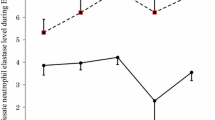Abstract
The intrapulmonary thrombi that form after the cessation of circulation are thought to be one of the major causes of graft function failure. We evaluated the effect of recombinant tissue-type plasminogen activator (rt-PA) in a canine cadaver lung transplant model. Donor dogs were killed by the intravenous administration of pancuronium bromide without heparinization, and left for 2h at room temperature. The donor lungs were then flushed with low potassium dextran glucose (LPDG) solution, being subjected to a total ischemic time of 3h. Following left lung transplantation, the contralateral pulmonary artery of the recipient dogs was ligated. In group 1 (n=6), chloride solution was administered from the main pulmonary artery for 90 min, commencing 15 min prior to reperfusion. In group 2 (n=6), 2.5 μg/kg per min of rt-PA, and in group 3 (n=6), 5.0 μg/kg per min of rt-PA, were continuously infused in the same manner as in group 1. Lung function, including arterial blood gases and pulmonary hemodynamics, was measured for 3h. The side effects of rt-PA were evaluated by measuring the prothrombin time (PT), activated partial thromboplastin time (APTT), fibrinogen, alpha2-plasmin inhibitor (α2-PI), plasminogen, and fibrin/fibrinogen degradation product (FDP). All of the animals in the three groups survived throughout the observation period. The group 3 animals had significantly better gas exchange than the group 1 animals, and the pulmonary hemodynamics were significantly better in the group 2 and 3 animals than in the group 1 animals. The FDP levels in the group 2 and 3 animals were significantly higher than those in the group 1 animals, while the PT and APTT were significantly prolonged in the group 3 animals. These findings led us to conclude that rt-PA improves early lung function, particularly pulmonary hemodynamics.
Similar content being viewed by others
References
Kayano K, Date H, Uno K, Shimizu N, Teramoto S (1993) Evaluation of viability of the canine cadaver lung for transplantation. Acta Med Okayama 47:329–337
Umemori Y, Date H, Uno K, Aoe M, Ando A, Shimizu N (1995) Improved lung function by urokinase infusion in canine lung transplantation using non-heart-beating donor. Ann Thorac Surg 59:1513–1518
Nishi H (1997) Successful canine cadaver lung transplantation after 18-hour preservation (in Japanese). Nippon Kokyuuki Geka Gakkai Zasshi (J Jpn Assoc Chest Surg) 11:25–33
Date H, Matsumura A, Manchester JK, Obo H, Lima O, Cooper JM, Sundaresan S, Lowry OH, Cooper JD (1993) Evaluation of lung metabolism during successful twenty-four-hour canine lung preservation. J Thorac Cardiovasc Surg 105:480–491
Clauss AV (1957) Gerinnungsphysiologische Schnellmethode zur Bestimmung des Fibrinogens. Acta Haematol 17:237–246
Friberger P, Knos M (1979) Plasminogen determination in human plasma. In: Scully MF, Kakkar VV (eds) Chromogenic peptide substrates: chemical and clinical usage. Churchill Livingstone, Edinburgh, pp 128–139
Date H, Matsumura A, Manchester JK, Cooper JM, Lowry OH, Cooper JD (1993) Changes in alveolar oxygen and carbon dioxide concentration and oxygen consumption during lung preservation. J Thorac Cardiovasc Surg 105:492–501
Novick RJ, Kenneth EG, Imtiaz SA, John L (1996) Lung Preservation: the importance of endothelial and alveolar type II cell integrity. Ann Thorac Surg 62:302–314
Ulicny KS, Egan TM, Lambert CJ, Reddick RL, Wilcox BR (1993) Cadaver lung donors: effect of preharvest ventilation on graft function. Ann Thorac Surg 55:1185–1191
Yamasaki F, Wada H, Aoki M, Inui K, Hitomi S (1989) An evaluation of the tolerance of autotransplanted canine lung against warm ischemia. Jpn J Surg 19:326–333
Egan TM, Lambert CJ, Reddick RL, Ulicny KS, Keagy BA, Wilcox BR (1991) A strategy to increase the donor pool: use of cadaver lungs for transplantation. Ann Thorac Surg 52:1113–1121
Egan TM, Ulicny KS, Lambert CJ, Wilcox BR (1993) Effect of a free radical scavenger on cadaver lung transplantation. Ann Thorac Surg 55:1453–1459
Hoylaerts M, Rijken DC, Lijinen HR, Collen D (1982) Kinetics of the activation of plasminogen by human tissue plasminogen activator. J Biol Chem 257:2912–2919
Petitpretz P, Simmoneau G, Cerrina J, Musset D, Dreyfus M, Vandenbroek MD, Duroux P (1984) Effects of a single bolus urokinase in patients with life-threatening pulmonary emboli: a descriptive trial. Circulation 70:861–866
Editorial (1992) Thrombolysis for pulmonary embolism. Lancet 340:21–22
Goldhaber SZ, Haire WD, Feldstein ML, Feldstein ML, Miller M, Toltzis R, Smith JL, Silva AT, Come PC, Lee RT, Parker JA, Mogtader A, Mcdonough TJ, Braunwald E (1993) Alteplase versus heparin in acute pulmonary embolism: randomised trial assessing right-ventricular function and pulmonary perfusion. Lancet 341:507–511
Staub NC, Schulz EL, Albertine KH (1982) Leukocytes and pulmonary microvascular injury. Ann NY Acad Sci 384:332–343
Agnelli G, Buchanan MR, Fernandez F, Boneu B, Van Ryn J, Hirsh J (1985) A comparison of the thrombolytic and hemorhagic effects of tissue-type plasminogen activator and streptokinase in rabbits. Circulation 72:178–182
Agnelli G, Buchanan MR, Fernandez F, Van Ryn J, Hirsh J (1985) Sustained thrombolysis with DNA-recombinant tissue-type plasminogen activator in rabbits. Blood 66:399–401
Agnelli G, Buchanan MR, Fernandez F, Hirsh J (1985) The thrombolytic and hemorrhagic effects of tissue-type plasminogen activator: influence of dosage regimens in rabbits. Thromb Res 40:769–777
Rao AK, Pratt C, Berke A, Jaffe A, Ockene I, Schreiber TL, Bell WR, Knatterud G, Robertson TL, Terrin ML, for the TIMI Investigators (1988) Thrombolysis in myocardial infarction (TIMI) trial-phase I: hemorrhagic manifestations and changes in plasma fibrinogen and the fibrinolytic system in patients treated with recombinant tissue plasminogen activator and streptokinase. J Am Coll Cardiol 11:1–11
Bovil EG, Terrin ML, Stump DC, Berke AD, Frederick M, Collen D, Feit F, Gore JM, Hills LD, Lambrew CT, Leiboff R, Mann KG, Markis JE, Pratt CM, Sharkey SW, Sopko G, Tracy RP, Chesebro JH, for the TIMI Investigators (1991) Hemorrhagic events during therapy with recombinant tissu-type plasminogen activator, heparin, and aspirin for acute myocardial infarction. Results of the thrombolysis in myocardial infarction (TIMI), phase II trial. Ann Intern Med 115:256–265
Author information
Authors and Affiliations
Rights and permissions
About this article
Cite this article
Akasaka, S., Nishi, H., Aoe, M. et al. The effects of recombinant tissue-type plasminogen activator (rt-PA) on canine cadaver lung transplantation. Surg Today 29, 747–754 (1999). https://doi.org/10.1007/BF02482320
Received:
Accepted:
Issue Date:
DOI: https://doi.org/10.1007/BF02482320




